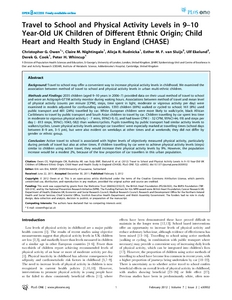Owen, CG; Nightingale, CM; Rudnicka, AR; Sluijs, EM; Ekelund, U; Cook, DG; Whincup, PH
(2012)
Travel to School and Physical Activity Levels in 9-10 Year-Old UK Children of Different Ethnic Origin; Child Heart and Health Study in England (CHASE).
PLOS ONE, 7 (2).
e30932.
ISSN 1932-6203
https://doi.org/10.1371/journal.pone.0030932
SGUL Authors: Cook, Derek Gordon Nightingale, Claire Owen, Christopher Grant Rudnicka, Alicja Regina Whincup, Peter Hynes
![[img]](https://openaccess.sgul.ac.uk/1385/1.hassmallThumbnailVersion/pone.0030932.pdf)  Preview |
|
["document_typename_application/pdf; charset=binary" not defined]
Published Version
Download (232kB)
| Preview
|
Abstract
BACKGROUND: Travel to school may offer a convenient way to increase physical activity levels in childhood. We examined the association between method of travel to school and physical activity levels in urban multi-ethnic children.
METHODS AND FINDINGS: 2035 children (aged 9-10 years in 2006-7) provided data on their usual method of travel to school and wore an Actigraph-GT1M activity monitor during waking hours. Associations between method of travel and mean level of physical activity (counts per minute [CPM], steps, time spent in light, moderate or vigorous activity per day) were examined in models adjusted for confounding variables. 1393 children (69%) walked or cycled to school; 161 (8%) used public transport and 481 (24%) travelled by car. White European children were more likely to walk/cycle, black African Caribbeans to travel by public transport and South Asian children to travel by car. Children travelling by car spent less time in moderate to vigorous physical activity (-7 mins, 95%CI-9,-5), and had lower CPM (-32 CPM, 95%CI-44,-19) and steps per day (-813 steps, 95%CI,-1043,-582) than walkers/cyclists. Pupils travelling by public transport had similar activity levels to walkers/cyclists. Lower physical activity levels amongst car travellers' were especially marked at travelling times (school days between 8-9 am, 3-5 pm), but were also evident on weekdays at other times and at weekends; they did not differ by gender or ethnic group.
CONCLUSION: Active travel to school is associated with higher levels of objectively measured physical activity, particularly during periods of travel but also at other times. If children travelling by car were to achieve physical activity levels (steps) similar to children using active travel, they would increase their physical activity levels by 9%. However, the population increase would be a modest 2%, because of the low proportion of car travellers in this urban population.
| Item Type: |
Article
|
| Additional Information: |
©2012 Owen et al. This is an open-access article distributed under the terms of the Creative Commons Attribution License, which permits unrestricted use, distribution, and reproduction in any medium, provided the original author and source are credited. |
| Keywords: |
Child, Child Welfare, England, Ethnic Groups, Humans, Motor Activity, Schools, Transportation, Science & Technology, Multidisciplinary Sciences, Science & Technology - Other Topics, RANDOMIZED CONTROLLED-TRIAL, ADOLESCENTS, WALKING, YOUTH, OBESITY, INTERVENTIONS, PATTERNS, TRENDS, SCHOOLCHILDREN, PERCEPTIONS |
| SGUL Research Institute / Research Centre: |
Academic Structure > Population Health Research Institute (INPH) |
| Journal or Publication Title: |
PLOS ONE |
| ISSN: |
1932-6203 |
| Related URLs: |
|
| Web of Science ID: |
WOS:000302178400021 |
| Dates: |
| Date |
Event |
| 2012-02-03 |
Published |
|
  |
Download EPMC Full text (PDF)
|
 |
Download EPMC Full text (HTML)
|
| URI: |
https://openaccess.sgul.ac.uk/id/eprint/1385 |
| Publisher's version: |
https://doi.org/10.1371/journal.pone.0030932 |
Statistics
Item downloaded times since 30 Apr 2012.
Actions (login required)
 |
Edit Item |



